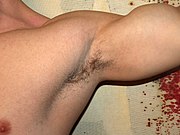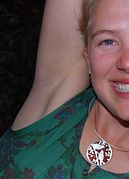Underarm hair
Underarm hair (Sometimes called axillary hair or armpit hair) is the composition of hair in the underarm area (axilla).
Development and function
Underarm hair, as human body hair, normally starts to appear at the beginning of puberty, with growth usually completed by the end of the teen-age years. The evolutionary significance of human underarm hair is still debated. It naturally wicks sweat or other moisture away from the skin, aiding in keeping well-ventilated skin dry enough to prevent colonization by odor-producing bacteria.[1] Underarm hair may also provide a natural anti-friction quality between the upper arm and the thorax.[citation needed]. A more controversial view is that it may facilitate the release of sexual-attractant pheromones from the underarm. [citation needed]
-
Male axilla with hair
-
Male axilla without hair
-
Female axilla with hair
-
Female axilla without hair
Cultural attitudes
Today it is more common in much of the Western world for women than men to shave their underarm hair regularly. The prevalence of this practice varies widely, though. Religious reasons are sometimes cited; for example, in the Islamic culture, both men and women practice the removal of underarm hair to meet religious guidelines of cleanliness. Many competitive swimmers remove nearly all of their body hair, including their underarm hair, to make their bodies more streamlined during races. Many male bodybuilders also remove their body hair, as do many (but not all) models in various kinds of erotica.
Removal of the hair from the underarms was part of a collection of hygienic or cosmetic practices recommended by Prophet Muhammad (570-632) as consistent with Fitra for both men and women and has since usually been regarded as a requirement by most Muslims.[2]
Seneca the Younger suggests it was common practice in ancient Rome, contrary to leg hair removal: «One is, I believe, as faulty as the other: the one class are unreasonably elaborate, the other are unreasonably negligent; the former depilate the leg, the latter not even the armpit» (letter 114).
In the West, the practice began for cosmetic reasons around 1915 in the United States and United Kingdom, when one or more magazines showed a woman in a dress with shaved underarms. Regular shaving became feasible with the introduction of the safety razor at the beginning of the 20th century. While underarm shaving was quickly adopted in some English speaking countries, especially in the US and Canada, it did not become widespread in Europe until well after World War II.[3]
Effects of shaving
It is a commonly believed myth that shaving hair will cause it to grow thicker over time.[4] Since there is nothing about the practice of shaving that produces new follicles from which new hairs could grow, this myth most likely persists because stubble does not taper like hair that is allowed to grow long, and because short hairs feel coarser than longer hairs of the same thickness. However, shaving does increase the likelihood of developing ingrown hairs. Armpit hair removal must be performed more frequently than arm or leg shaving, as underarm hair grows faster than arm or leg hair, and if not done consistently, stubble can appear. The armpit area can darken over a period of time, and even with a close shave, a "5 o'clock shadow" may be visible. Because hair under the skin can contribute to a dark appearance of the underarm, waxing, by removing the hair from the root, can effectively reduce this darkness.[5]
Underarm hair in art
In works of art, the underarm hair is usually removed; showing it is a mark of modernism.[citation needed] This contrasts to the depiction of pubic hair in art, which is rarely portrayed in works created in the Middle Ages, increasingly common in Renaissance art, and quite frequent in modern times.[6]
Articles
References
- ^ Marc Paye, Howard I. Maibach, André O Barel (2009). Handbook of cosmetic science and technology (3 ed.). Informa Health Care. p. 703. ISBN 1-4200-6963-2.
- ^ USC Compendium of Islamic Texts, retr. 24 Mar 2012: http://www.cmje.org/religious-texts/hadith/muslim/002-smt.php#002.0502
- ^ The Hairless Ideal: Women and Their Body Hair Susan A. Basow1 Lafayette College doi:10.1111/j.1471-6402.1991.tb00479.x Psychology of Women Quarterly March 1991 vol. 15 no. 1 83-96
- ^ Urban Legends Reference Pages: Shaved Hair Grows Darker
- ^ In addition to waxing, a Razoraid can be used to free trapped ingrown hairs as well as to relieve the pain associated with PFB. Dark Underarm
- ^ jstor



